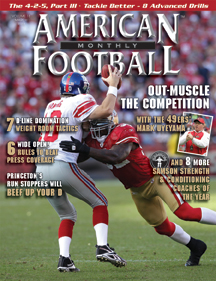Article CategoriesAFM Magazine
|
7 Steps to Dominance - Building Dominant Linemen in the Weight Room and On the Fieldby: Steve MorrisExplosive Football Training © More from this issue Too many football strength programs train their linemen the same way as everyone else on the team. If your offensive and defensive linemen are doing the exact same workouts as your quarterbacks, they’ll never reach their full potential. All but one of these can be trained in the weight room. But, you have to take into consideration that, at the high school and college level, linemen need special attention. If they’re over-fat and big, they’ll have a longer-than-normal recovery time which is not good. Once you lean them out a bit, their work capacity will be higher than most of the other players on the team. They can handle more work and will generally progress faster. So, how do you take the average freshman or sophomore and turn them into the ideal lineman? That is, big, strong and fast with great feet and superior technique? Follow these 7 steps and you’ll soon have a team full of dominating linemen on both sides of the ball. What a player can do for 8 reps is 100% determined by what his max single is, but never the other way around. Maximum strength is responsible for all other facets of athleticism – speed, explosiveness, agility, starting strength, etc. So, you need to have your offensive and defensive linemen doing heavy, low-rep sets, even as low as singles (when they’re ready for that). They need to be working at over 85% of their max for sets of 3 and below. This forms the base of their workouts. Lead off a workout with a heavy movement like most of those listed below, for heavy, low reps. Then you can go onto more moderate reps and sets on assistance exercises. Add these to the end of the workouts to get your guys moving in different ways. The side-to-side medicine ball passes will really improve the coordination between their upper body, hips and legs. Luckily, this is a fairly easy problem to fix. Just have your linemen: While the hips and legs as a whole are worked, these exercises tend to leave gaps in strength, especially in the inner thighs and hip abduction and adduction. Just ask your guys how they feel the day after their first time doing Lateral Lunge. They’ll let you know some muscles weren’t getting worked! Simply adding Lateral Lunges, 45-Degree Angle Lunges and Asterisks Lunges to your linemen’s workouts will work wonders for their lateral speed. And, if they’re really lacking, have them get a band or cable and do standing abductions and adductions. A few sets of 10, once a week, will make sure these muscles stay strong and injury free. Take the average O-lineman, have him do his steps every session, and on off days, at home. In the course of one off season he’ll have taken several thousand perfect steps (doing them perfectly is crucial). Obviously, working on a skill a thousand plus times is going to make him much better so begin to put these into their workouts. They can warm up with blocking shields, firing off the ball, hand play, pass blocking drills, etc. It’ll only add 5 minutes or so to their workouts but the effect is amazing and long term. Using weight is the #1 way to build your strength for football. Barbells, Dumbbells and Kettlebells are the foundation of any good football training program. But, they do have some limitations when used alone. Yes, they build tremendous strength, but they can leave small gaps between weight room strength and football strength. We call this ‘strength leakage or strength gaps.’ We’ve all seen the guy who can bench 400 lbs. but can’t block the sun. This guy might even be a decent athlete, so why can’t he dominate on the field? He allowed himself to develop gaps in his strength so that he can’t take what he gained in the weight room and apply it to the field. He literally leaks strength from his joints or at his waist, and can’t apply his power to an opponent. By using sandbags, especially when doing cleans, c and j’s, or any kind of squatting, you are teaching the body to transfer power from the ground up, through the hips and mid-section. You also train the stabilizers, tendons and ligaments because the bag changes shape on almost every rep. There’s no way to settle into a groove when lifting a sandbag. This is how they prevent leakage – they train you in odd positions and hit those stabilizers in a way that weights alone cannot do. To ensure that you transfer your weight room gains to the field, sandbags are essential. Work those stabilizers in odd positions from varying angles with an implement that never stays the same shape twice. Sounds like a recipe for football success. Use sandbags for exercises like: Seriously though, linemen are too big for that kind of running and it’s slow-twitch fiber running. Your linemen (and all your players) should be working on the fast-twitch end. Plus, conditioning should both mirror what you do in a game and build mental toughness. On the mental toughness end, any sort of sled pushing/pulling mixed with short sprints and/or strongman type exercises like Tire Flips, Farmers Walks or Medleys are all recommended. For football-specific conditioning, use game-simulated conditioning. Basically, you have your linemen line up in a good stance, take the steps they would in a game, then sprint in ways that are similar to what they do on the football field. For example, a defensive linemen’s conditioning might look like this -
|
|
| HOME |
MAGAZINE |
SUBSCRIBE | ONLINE COLUMNISTS | COACHING VIDEOS |
Copyright 2024, AmericanFootballMonthly.com
All Rights Reserved




